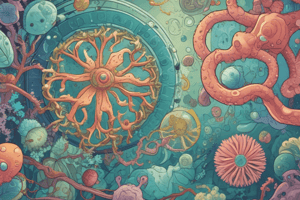Podcast
Questions and Answers
What is microbiology?
What is microbiology?
The study of microorganisms.
Which of the following describes bacteria?
Which of the following describes bacteria?
- Bacteria can be described in terms of their shapes. (correct)
- Bacteria are multicellular organisms.
- All bacteria are harmful.
- Bacteria are found in nearly every habitat on Earth. (correct)
All protozoa are pathogenic.
All protozoa are pathogenic.
False (B)
What are unicellular eukaryotes that are not plants, animals, or fungi called?
What are unicellular eukaryotes that are not plants, animals, or fungi called?
What are the cell walls of fungi primarily made of?
What are the cell walls of fungi primarily made of?
What role do molds play in the environment?
What role do molds play in the environment?
What are helminths?
What are helminths?
What is a bacteriophage?
What is a bacteriophage?
The cell can be defined as a basic functional unit of ____.
The cell can be defined as a basic functional unit of ____.
Which of the following statements about viruses is true?
Which of the following statements about viruses is true?
Flashcards are hidden until you start studying
Study Notes
Microbiology
- The study of microorganisms, which are biological entities too small to be seen with the naked eye
- Microorganisms inhabit every corner of the Earth
- Microorganisms are responsible for deadly diseases and are the basis of many industrial processes
- Microorganisms are typically smaller than 100 micrometers
Types of Microorganisms
- Bacteria
- Found in nearly every habitat on earth, including within and on humans
- Most bacteria are harmless or helpful
- Some are pathogenic, causing diseases in humans and other animals
- Often described by shape:
- Spherical (coccus)
- Rod-shaped (bacillus)
- Curved, wavy (spirillum)
- Spiral (spirochete)
- Vibrio
- Protists
- Unicellular eukaryotes that are not plants, animals, or fungi
- Types:
- Algae: Plant-like protists that can be either unicellular or multicellular
- Cell walls made of cellulose
- Protozoa: Very diverse
- Some are photosynthetic, others feed on organic material
- Can be free-living or parasitic
- Most are harmless, but some are pathogens that can cause disease in animals or humans
- Algae: Plant-like protists that can be either unicellular or multicellular
- Fungi
- Eukaryotes
- Some multicellular fungi, such as mushrooms, resemble plants
- Some are pathogenic
- Not photosynthetic, and their cell walls are usually made out of chitin rather than cellulose
- Unicellular fungi (yeasts) are included within the study of microbiology
- Examples:
- Oral candidiasis (yeast infection)
- Mushrooms
- Molds
- Made up of long filaments that form visible colonies
- Found in many different environments, from soil to rotting food
- Play a critical role in the decomposition of dead plants and animals
- Some molds can cause allergies, and others produce disease-causing metabolites called mycotoxins
- Used to make pharmaceuticals, including:
- Penicillin (blue green mold fungi), an antibiotic
- Cyclosporine, used to prevent organ rejection
- Helminths
- Multicellular parasitic worms
- Are not technically microorganisms, as most are large enough to see without a microscope
- However, these worms fall within the field of microbiology because diseases caused by helminths involve microscopic eggs and larvae
- Example:
- Taenia saginata, infects both cattle and humans
- T.saginata eggs are microscopic (around 50 µm), but adult worms can reach 4–10 m, residing in the digestive system.
- Viruses
- Acellular microorganisms, meaning they are not composed of cells
- Consist of proteins and genetic material—either DNA or RNA, but never both—that are inert outside of a host organism
- Incorporate themselves into a host cell to multiply and infect other hosts
- Can infect all types of cells, from human cells to the cells of other microorganisms
- Responsible for numerous diseases in humans
- Bacteriophage: A virus that infects and replicates within bacteria, used as an alternative to antibiotics
Bacterial Structure and Organization
- The Cell
- The basic functional unit of life
- Performs individual functions
- All living organisms are composed of:
- One cell (single cell) - Unicellular organisms (prokaryotic organisms including bacteria)
- Many cells (multi-cellular organisms) - Multicellular organisms (eukaryotic organisms)
Studying That Suits You
Use AI to generate personalized quizzes and flashcards to suit your learning preferences.




